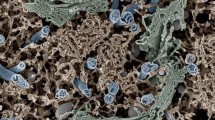Abstract
IT has become customary in studies of the nerve cell by electron microscopy to apply the term ‘Golgi apparatus’ to appearances suggesting membranes, granules, or vacuoles1. In size, general configuration and osmiophilia the objects so designated cannot readily be recognized as forming part of the large intracellular ‘network’ familiar to workers with the light microscope. Moreover, adequate controls of these observations are prevented by the short periods (2–12 hr.) of osmication usual in the preparation of tissues for electron microscopy. As is well known, tissues must remain in osmic solutions for days or weeks before the capricious impregnation of the Golgi apparatus results. Further, it has been suggested that the initial buffering of the osmium fixative used in electron microscopy prevents for some reason the classical ‘black reaction’ of Kopsch (Gatenby, J. B., personal communication, 1958).
Similar content being viewed by others
References
Gatenby, J. B., and Lufty, R. G., Nature, 177, 1027 (1956).
Golgi, C., Arch. Ital. Biol., 30, 60 (1898).
Barton, A. A., and Causey, G., J. Anat., 92, 399 (1958).
Author information
Authors and Affiliations
Rights and permissions
About this article
Cite this article
THOMAS, O. Electron Microscopy of the Golgi Apparatus. Nature 185, 703–704 (1960). https://doi.org/10.1038/185703a0
Issue Date:
DOI: https://doi.org/10.1038/185703a0
- Springer Nature Limited
This article is cited by
-
Ultrastructure of foam cell nephropathy
Virchows Archiv Abteilung A Pathologische Anatomie (1968)
-
The finer structure of synapses and neurones
Spinal Cord (1964)





